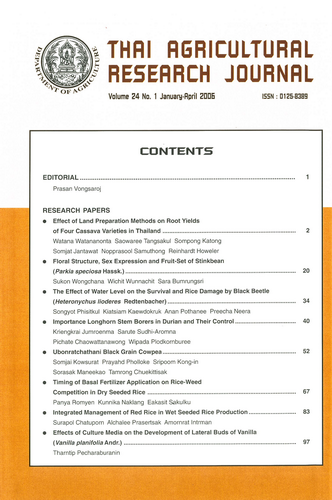Effect of Land Preparation Methods on Root Yields of Four Cassava Varieties in thailand
Keywords:
land preparation, cassava variety, starch contentAbstract
Cassava has been growing in Thailand with a 3-disk plow followed by a 7-disk harrow and ridgine for land preparation. this method of land preparation results in a very loose soil which in free of weeds and easy to plant. However, it has also led to the formation of a compacted subsoil or "plowsole". A trial on alternative methods of land preparation was conducted a t three sites namely farmer;s field near Rayong field Crops Research Centre, Rayong province, Thai Tapicoca Development Institute (TTDI) in Huay Bong, Nakhon Ratchasima province and Khaw Hin Sorn Research Station, chachoengsao province to determine the effect of land preparation on the root yield of four cassava varieties in 2001 to 2003. In the 2nd and the 3rd year, the use of a subsoiler followed by 3-disk plow produced the highest root yield of 4.57 and 4.43 t/rai; this treatment also resulted in the highes tnet income in the 3rd year at a farmer;s field near rayong Field Crops Research Centre. Rayong 5 variety produced the highest fresh root yield while Rayong 90 had the highest starch content. At the Thai Tapicoa Development in the 1 st and the 2nd years, the use of a subsoiler followed by chisel produced the highest root yield of 3.50 and 4.59 t/rai but the no-tillage treatment produced the highes tnet income in the 3rd year. Rayong 90 produced the highest fresh root yield and as well as the highest starch content. At Khas Hin Sorn Research Station of Kasetsart University in Chachoengsao. In the 1st and the 2 nd years, the traditional use of the 3-disk plow followed by 7-disk harrow and contour ridging the highest root yield of 3.98 and 7.42 t/rai, were obtained but the use of a subsoiler followed by 3-disk plow and 7-disk harrow produced the highest net income in the 3rd year. Among the four varieties, Royong 72 produced the highest yield, but with the lowest starch content, while Rayong 90 had the lowest yields but the highest starch content.
Downloads
Published
How to Cite
Issue
Section
License
Copyright (c) 2017 วารสารวิชาการเกษตร (Thai Agricultural Research Journal)

This work is licensed under a Creative Commons Attribution-NonCommercial-NoDerivatives 4.0 International License.
Thai Agricultural Research Journal



